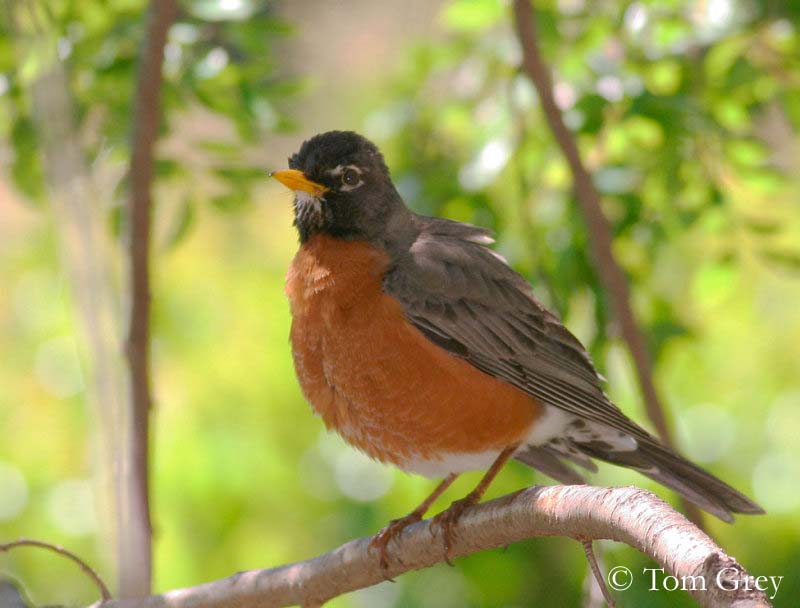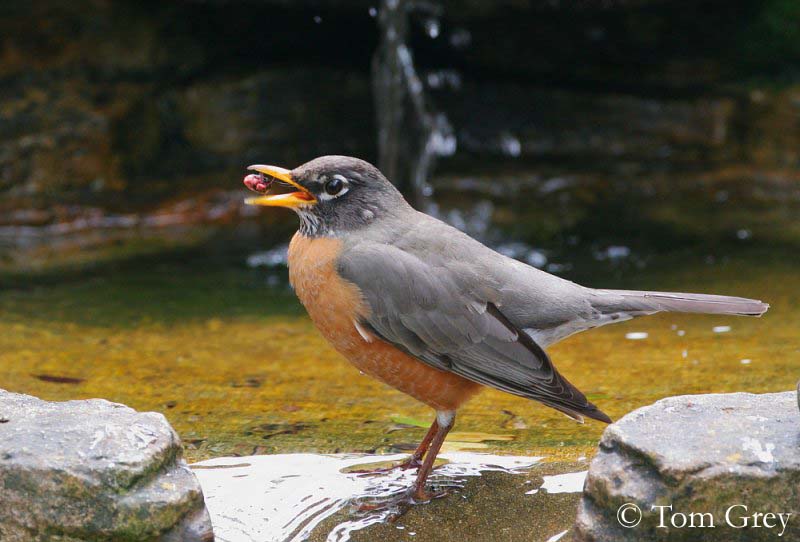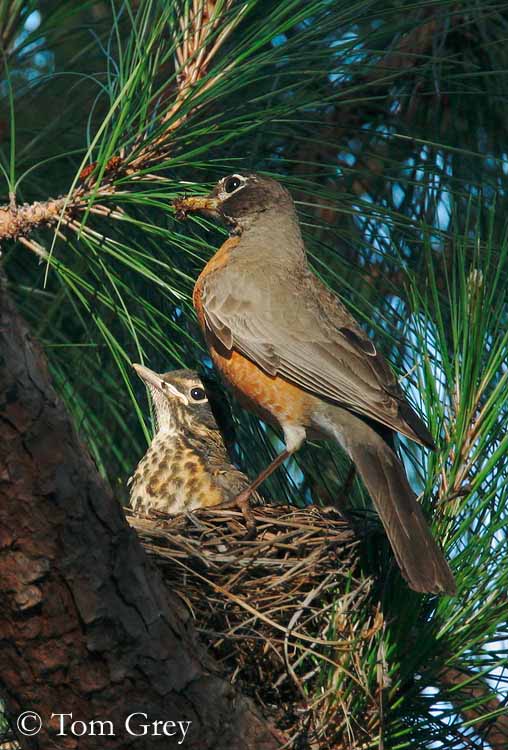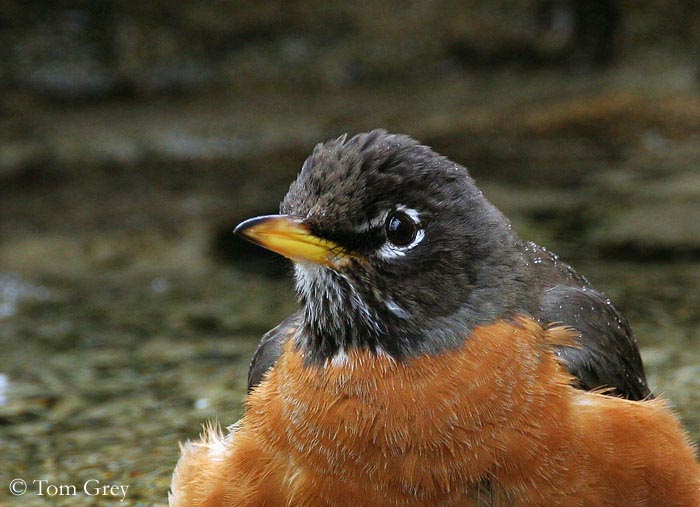
American Robin
Turdus migratorius
Passeriforme Order – Turdidae Family
BIOMETRICS :
Length: 23-28 cm ; Wingspan: 31-40 cm ; Weight: 77 g
LONGEVITY: up to 14 years
DESCRIPTION:
American Robin has grey brown upperparts, with darker head and tail. Bill is yellow with black tip. Underparts are orange-red. Lower belly and undertail coverts are white. Blackish head contrasts with two mid-crescents surrounding the eyes. White throat is streaked black.
Bill is yellow with blackish tip. Eyes are dark brown. Legs are brown yellow. In flight, we can see the small corners of the tail, and bright dark red under wings coverts.
Female is duller and smaller than male, with pale scaly on flanks.
Juvenile is spotted. It is similar to adult, with dark spots on underparts, and pale edges above.

VOICE: SOUNDS BY XENO-CANTO
American Robin has a loud call, very liquid, a variable “cheerily-cheer-up-cheerio”. Calls include a rapid “tut,tut,tut”, and a tiny high pitched “ssip” in flight.
Young warbles when begging for food. Adults use warblers and chatters if they are threatened by a predator. Male begins to sing at the end of winter to early summer, and rather early morning. It generally perches on tree top or building when singing.
HABITAT:
American Robin lives in dense forests, grasslands and fields. In winter, we find it in wet woodlands, marshes, urban areas and parks. It prefers open lands with short grass to feed, with trees and bushes to nest and roost.
It is a North American species, very rare and occasional in Europe.
RANGE:
American Robinn lives in Southern Canada, British Columbia and United States. It migrates southwards to winter, to southern Mexico and Guatemala. During summer, it is found in northern Canada and Alaska.
BEHAVIOUR:
Hundreds and even thousands of American Robins may gather in winter to roost. During summer, females remain at nest and males gather. When the juveniles become independent, they join the males. Adult females join them at the end of the breeding season.
American Robin feeds on different kinds of food, according to the season. It feeds on earthworms early in the day, and fruits later. It hops on the spot to get worms on surface, and turns the head to see well.

American Robin may produce three clutches per year. Only 40% of the nests get young and only 25% survive after November. Pairs form only for one breeding season. American Robin breeds in spring, when it arrives from winter areas. Season lasts from April to July.
American Robin is active during the day. It is a gregarious bird, especially in winter, gathering in large flocks on winter areas. They gather at night, often in wet areas with dense vegetation, to roost among trees. They feed during the day in smaller flocks, feeding on fruits and berries.
American Robin defends its territory during the breeding season. Youngs remain in the nest area during the first four months of their lives. They gather in varied age flocks when it is time to migrate.
FLIGHT:
In flight, the reddish underparts are conspicuous. American Robin is able to fly long distances in migration. It flies very often near the ground, and only on short distances.

REPRODUCTION:
American Robin’s nest is cup shaped, built by female which makes outer foundations with tall weeds, twigs, paper and feathers, woven together. The nest is lined with mud, moulding it with its breast, and later, she adds thin grasses or other soft material to protect its eggs.
Nest may be situated on ground, or high in tree, but usually between 1,50 and 5 metres above the ground, in a dense shrub, in a tree fork or on building. Nest needs support and protection from rain. A new nest is built for each new brood. Generally, the first clutch is in an evergreen tree and others in deciduous trees.

Female lays 3 to 5 bluish green eggs. Incubation lasts about 14 days, by female. Then, she feeds the chicks. When they grow, she broods them only at night when the weather is bad. Youngs fledge at about two weeks of age. Even after fledging, they follow their parents and beg for food. They remain hidden on the ground during this period. Two weeks later, they are able to fly.
DIET:
American Robin feeds on fruits (60%) and invertebrates (40%). Earthworms are very important during breeding season, but in winter, they feed mainly on fruits.

PROTECTION / THREATS / STATUTS:
Populations of this species are stable, even increasing within the range. But because American Robin feeds on greens, it is threatened by pesticides, and it plays an important role to control chemical pollution levels.
Youngs have predators, such as squirrels, snakes, Blue Jays, crows and ravens. Adults may be killed by raptors, domestic cats and large snakes. After killed by hunting in order to eat them, American Robin is now protected in United States.
Fr: Merle d’Amérique
All : Wanderdrossel
Esp : Robín Americano
Ital : Tordo migratore
Nd : Roodborstlijster
Photographs by Tom Grey
His website: Tom Grey's Bird Pictures
Text by Nicole Bouglouan
Sources:
A GUIDE TO THE BIRDS OF MEXICO AND NORTHERN CENTRAL AMERICA by Steve N. G. Howell, Sophie Webb - Oxford University Press - ISBN: 0198540124
FIELD GUIDE TO THE BIRDS OF NORTH AMERICA - National Geographic Society - ISBN: 0792274512
THE HANDBOOK OF BIRD IDENTIFICATION FOR EUROPE AND THE WESTERN PALEARCTIC by Mark Beaman, Steve Madge - C.Helm - ISBN: 0713639601
All About Birds (Cornell Lab of Ornithology)
Animal Diversity Web (University of Michigan Museum of Zoology)
What Bird-The ultimate Bird Guide (Mitchell Waite)
Wikipedia (Wikipedia, The Free Encyclopedia)
Bird Web (Seattle Audubon Society)